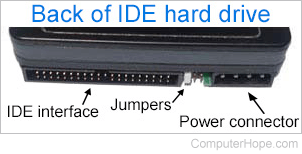Primary

In general, primary refers to something ordered first in a sequence, or something of first-order importance. With computer hard drives, a primary drive is the first drive on a computer with more than one drive. For example, in Windows, the primary drive is the C: drive. If you had another hard drive in Windows, it would likely be the D: drive.
Primary drive
A hard drive may also be a Pri master, which indicates the hard drive is the primary drive on the primary data channel of its connection to the motherboard.
Primary jumper setting
A primary jumper setting is found on a hard drive or CD-ROM (compact disc read-only memory) drive, and adjusted using jumpers, as shown below. The primary setting allows two devices to be attached to a single IDE (integrated drive electronics)/ATAPI (AT Attachment Packet Interface) connection.

With early hard drives, this setting was called a "master" setting. However, because "master" is offensive in this context, it's better to refer to this drive as "primary" or "device0."
Primary partition
The primary drive may also have a primary partition, which is the first partition containing a single file system (but is not necessarily ordered first on the drive). A hard drive can contain up to four primary partitions, only one of which can be "active" (bootable). By contrast, an extended partition can contain multiple logical partitions, each with a different filesystem. A hard drive can contain only one extended partition.
